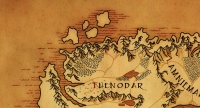Lore:Narthendar (region)
The Narthendar region is one of several that make up the Althas continent. This region is the home of the Thenodrim (once known as the Narthendi) and contains the kingdom of Thenodar (formerly the kingdom of Narthendar).
The meaning for the word Narthendar is unknown, as it comes from the now extinct Celestial language.
Contents
History
[WIP]
Geography
Thenodar is divided into four two major subregions:
- Hláfland ("High Land" in Old Maelan) makes up the North West
- Nitherland ("Low Land" in Old Maelan) makes up the South West
- Fennland ("Mire Land" in Old Maelan) makes up the South East
- Útland ("Out Land" in Old Maelan) makes up the North East
A ridge divides the land in half.
Nitherland
The south's topography is mostly made up of greener fields and rolling hills compared to the north. The fields make for great farmland.
Landmarks
- East Harath: Woods east of Mundmere Lake. Harath means "Wood" in Old Maelan.
- Mundmere: A large lake found at the center of the Narthendar region. The lake, making a natural defense to the northern part of the region, was an ideal location for the city of Esomjathi. Mundmere means "Guardian Lake" in Old Maelan.
- West Harath: Woods west of Mundmere Lake. Harath means "Wood" in Old Maelan.
Hláfland & Útland
The north's border acts as a large plateau. The northern uplands are very hilly and craggy (as are the north mountains) in both Hláfland and Útland. The center is fairly level and barren, a subtundra with tundra around the feet of the northern mountains. The upland hills are fairly craggy as are the northern mountains.
Landmarks
- Faesholt: Forest in northeastern Narthendar. Faesholt means "fringe forest" in Old Maelan.
- Haelscíma: The tallest mountain peak in all of Althas, located in northern Narthendar. The Thenodrim believe this location to be the place of their origin. Within the mountain can be found the ruins of Thovairozil, and beneath that the halls of Zalothairar. Haelscíma means "Shadow of Omen" in Old Maelan. In Noralar it is known as Voshellas, which means "World Pillar".
- Wídholt: Forest in northwestern Narthendar. Wídholt means "wide forest" in Old Maelan.
Rivers
- Èathegn: River west of Faesholt. Èathegn means "servant river" in Old Maelan, and was named by North Narthendar as it acted as a "servant" to the city of Randell.
- Èathéowe: River east of Faesholt. Èathéowe means "handmaiden river" in Old Maelan, and was named by North Narthendar as it acted as a "sister" river to Èathegn.
Climate
Although Thenodar is in the north, it's not freezing as one might expect. The mountains to the north, east, and west shield it from the harsh winds coming off the cold, northern ocean. The noticeably warmer southern winds are able to come up over the much lower southern mountains and hills as well as up through the large opening in the southeast. The north, however, are quite cold, with the higher elevation being a large part of it.
